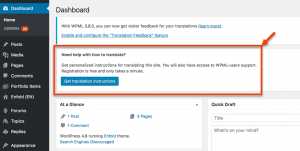WPML 3.8.0 puts a big focus on String Translation. It makes String Translation a lot simpler to configure and use and a lot faster.
Simpler “Theme and Plugins Localization”
You probably know that WPML’s String Translation includes many options. These options evolved over time, to answer different needs of different kinds of sites.
In WPML 3.8.0, we redesigned the admin screen for “Theme and plugins” localization, with two goals:
- To make it easy to understand what each option does
- To make it unnecessary to go to that admin screen for most sites
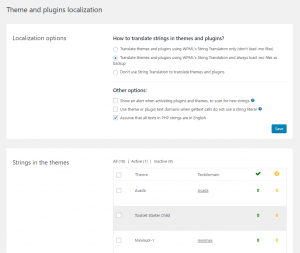
From the screenshot, you can see that the page looks a bit different. That’s not a big deal. The important thing to notice is the updated options. Even more important are the defaults.
Now, when you activate String Translation, it automatically applies the most convenient settings for your site, which ensure that everything gets translated and that performance is optimal.
(Much) Faster String Translation
String Translation in WPML 3.8.0 is faster because of three main changes:
- String Translation doesn’t run (at all) when it’s not needed. If you’re running English (in the admin or front-end) and all the strings are in English, there’s no need to run String Translation at all. 99% of the sites that use WPML have only PHP strings coming from English. This means that WPML doesn’t need to hook to the WordPress GetText functions. As a result, your WordPress admin and front-end in English will be a lot faster now.
- String Translation will block .mo files from loading by default. This option existed before but wasn’t the default, so many sites didn’t have this. As a result, there are plugins with huge .mo files (like WooCommerce), which paid twice in performance. Once to load WPML’s strings and the second to load the .mo files. Now, by default, only WPML’s strings load. For huge themes and plugins (like WooCommerce), loading WPML’s strings is actually faster than loading the entire .mo file.
- WPML automatically scans your site’s .mo files to ensure that all translations still load. Of course, it’s not enough to disable .mo files. Instead, WPML sees itself as responsible for finding and scanning these .mo files. The scanning is done once after installing or updating the theme or plugins.
Numbers?
On our own site, the overall CPU load is down by about 25% for the English homepage and admin dashboard. Execution time is down on all other languages because we no longer need to load huge .mo files.
The performance for each site will change differently, depending on the theme, plugins and your content.
Want to Have Better Translations?
WPML makes it easy now to ask visitors for feedback about translations.
Who needs it? Almost everyone running a multilingual site.
When you write a lot of text, there’s always a chance for a typo. When you’re translating, you also need to know the exact context and local jargon. Even a professional translator sometimes gets it wrong.
The problem with proofreading translated content is that you, who knows the business, don’t speak the language (otherwise you wouldn’t have sent it to translation).
WPML 3.8.0 lets you open pages for visitor feedback. Go to WPML -> Languages and scroll to the new Translation Feedback section.
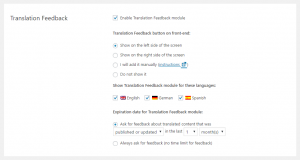
If you just enable it, the defaults are to allow feedback on new or modified content, updated within the last 30 days.
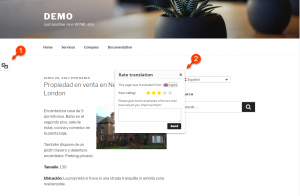
These pages will get a small “translation feedback” icon, which visitors can use. The feedback will go directly to you and you can assign it to the translator who worked on that page.
If you’re building sites for clients, this may seem a bit less interesting, but your clients will love it.
Accounts for End-Users
As of WPML 3.8.0, we invite your clients to have their own accounts in wpml.org. I wrote about it last week and I’d like to add a bit more information now.
First, it’s optional. If you don’t want WPML.org to have any relationship with your clients, you can completely disable this option.
What we’re planning for end-users is:
- To show instructions on how to translate sites, tailored per site and for “end users”. You’re going to see a button in the WordPress admin, offering personalized translation instructions. This link goes to WPML.org with information about the active theme and plugins.
Notice for the end-users with the link to translation instructions Clicking on it take you to a login/registration page. After, you get a table with instructions on how to translate each of the plugins and the theme. These instructions are written especially for non-developers.
- Offer support for “how to translate” to end-users. We’ve had talks with different folks who build sites with WPML and the repeating difficulty that we see is helping end-users with issues related to translation. We hope that if end-users will READ the documentation that we prepare for them, there will be fewer questions, but it’s never going to go down to zero. So, we’ve trained our supporters on how to help end-users, specifically with translation related questions. This support is strictly limited to managing content and will never include suggestions like “disable plugins”, etc. When we see that we need to talk with the developer, we’ll invite you (our client) to join the support thread. And, like WPML’s technical support, this end-user support will be available in all the languages we work in.
- Offer paid translation work and other end-user related services to the people who need it. In the last two years, we’ve been working with leading translation services on integration with WPML. These services offer outstanding and they’re all experts in WordPress translation now. If you’re developing sites, you’re probably much less interested in who translates. However, many “end users” actually spend a lot of time looking for the right translation service for their business. We think that this is a good opportunity to connect between those who offer the service and those who need it. You know our policy against SPAM and you know that we’ll only send these offers to people who are interested in them.
Easily Switch Between Production and Development Versions
Before we’re ready with new production versions, we prepare a set of “development” versions and then at least one beta.
WPML 3.8.0 makes it a lot easier to switch to non-production versions. Go to Plugins -> Add New and select the Commercial tab.
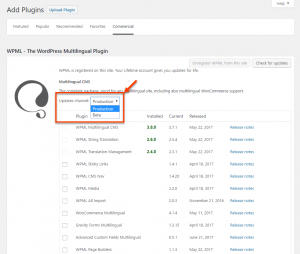
You’ll see a new option to choose the channel for WPML. When you change the channel, WPML will automatically download all the plugins that you need to be on that channel. You can just as easily switch back.
We hope that this will help you try new betas.
Availability and Release Schedule
We’ve just released the second beta for WPML 3.8.0. Because this version is the first to offer “channels”, you cannot yet switch to it from the admin. You’ll need to download the beta manually from your WPML.org account.
This version already passed a lot of testing, including by our compatibility team on dozens of themes and plugins. Still, we need about two weeks to complete full QA. Then, we’ll release WPML 3.8.0 as a “production” version.
If you’re developing sites for clients now, we encourage you to use this beta, but you shouldn’t yet run it on production sites.
Feedback? Ideas? Questions?
This release of WPML packs a lot of new stuff and improvements. We’re doing our very best to build the best WPML for you. Please let us know your thoughts in the comments below.

